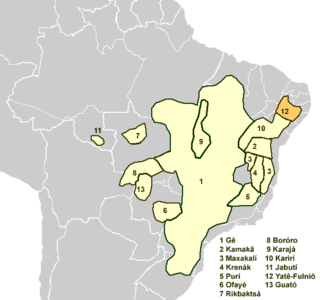Top Qs
Timeline
Chat
Perspective
Iatê language
Indigenous language of Brazil From Wikipedia, the free encyclopedia
Remove ads
Yatê, or Fulniô, is a language isolate of Brazil, and the only indigenous language remaining in the northeastern part of that country. The two dialects, Fulniô and Yatê, are very close. The Fulniô dialect is used primarily during a three-month religious retreat. Today, the language is spoken in Águas Belas, Pernambuco.[2]
You can help expand this article with text translated from the corresponding article in Portuguese. (April 2021) Click [show] for important translation instructions.
|
The language is also called Carnijó, and alternate spellings are Fornió, Furniô, Yahthe, and Iatê.
Remove ads
Classification
Kaufman (1990) classified Fulniô as one of the Macro-Jê languages. However, Eduardo Ribeiro of the University of Chicago, who is working on large-scale classification of Brazilian languages, finds no evidence to support this, and treats it as an isolate. Jolkesky (2016) again has it as Macro-Jê, but Nikulin (2020) again excludes it.
Phonology
Summarize
Perspective
Fulniô has the following sounds:
Consonants
- /pʰ/ is rare.
- A glottal stop [ʔ] occurs, but is considered epenthetic.
- /n/ can be heard as a velar nasal [ŋ] before a velar stop.
- /l/ can be heard as a palatal lateral [ʎ] before a post-alveolar affricate, and can be heard as an alveolar lateral flap [ɺ] when following fricatives, nasals or stops.
Vowels
Fulniô has 8 vowels.
- /a/ can be heard as nasalized [ə̃] when preceding a nasal consonant in closed syllables, or word-finally after a nasal consonant.
There are few contrasts between /o/ and /u/, suggesting /u/ is a recent addition, perhaps from Portuguese.
All seven have nasalized and glottalized allophones, depending on adjacent consonants. Vowels occur long and short. However, long vowels result from assimilation of /h/, are pronounced [Vh] in one dialect, and so are analyzed as /Vh/ sequences.
Tones are high and low. Contour tones occur allophonically adjacent to voiced consonants. Final syllables tend to lack a tone contrast, and final vowels may be devoiced or dropped.
There are no vowel sequences; vowels either coalesce or are separated by a glottal stop. Consonant clusters are limited to two consonants, apart from a possible additional /j w/, with the maximum syllable being CCCVC; reduced vowels between consonants are analyzed as /j w/ by Meland & Meland: /tfàltʰùlkja/ 'crossing over', /kwlèlja/ 'rotten'.
Remove ads
Vocabulary
Loukotka (1968)
Loukotka (1968) lists the following basic vocabulary items.[3]
Nikulin (2020)
Some Yaathê words given by Nikulin (2020),[4]: 69–70 cited from Lapenda (1965,[5] 2005 [1968][6]), Barbosa (1991),[7] Costa (1999),[8] F. Silva (2011a,[9] 2011b[10]), and Branner (1887).[11]
Bibliography
- Fulniô (Yahthe) Syntax Structure, Meland & Meland (2009 [1968])
- Phonemic Statement of the Fulniô Language, Meland & Meland (2010 [1967])
References
Wikiwand - on
Seamless Wikipedia browsing. On steroids.
Remove ads

